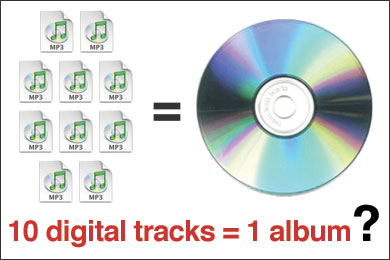
 The TEA concept creates a way to compare album and track sales in an apples to apples approach. This is especially helpful because the music marketplace has been rapidly evolving. But is the current 10 tracks = 1 album the best way to accomplish this task?
The TEA concept creates a way to compare album and track sales in an apples to apples approach. This is especially helpful because the music marketplace has been rapidly evolving. But is the current 10 tracks = 1 album the best way to accomplish this task?
Nielsen SoundScan recently announced that 2011 vs. 2010 music sales are showing a 1.6% increase through 5/8/2011. Good sales news has been in short supply for the music industry, making the release especially newsworthy. The number was calculated by combining physical and digital album sales plus track equivalent albums (TEA).
============
According to Nielsen SoundScan Data (through 5/8/2011):
Total Albums w/TEA +1.6%
Overall Albums -1.5%
Physical Albums -8.3%
Digital Albums +16.8%
Digital Tracks +9.6%
============
The actual number of tracks per album, however varies widely. For example, Jason Aldean’s latest chart topping hit album has 15 tracks. Katy Perry’s CD has 12 cuts plus there is a 17 cut deluxe version. Adele’s blockbuster album has 12 cuts. Then we also have six paks and eight paks. Regardless of the number of cuts an album contains, each time it’s scanned it counts as one unit.
Not surprisingly, rebalancing the equation could result in big swings. Looking at SoundScan numbers in the table below, using 11 tracks=1 album in 2011 would add 42 million equivalent albums compared with 46.3 million using 10 tracks=1 album.
Solutions?
Could this TEA process be improved? One way to sharpen the tabulations might be to calculate each album’s “TEA rate” based upon the number of cuts it contains. So for example Jason Aldean would have to sell 15 tracks from his current album to add an additional TEA unit to that album. And John Rich, who is releasing a new six pak this week would need only six downloads of any of the tracks contained on this new release to get a TEA unit credit. SoundScan is all about units—not dollars—so although this might seem unfair to artists with a higher number of cuts on an album, in reality it simply applies a constant yardstick across album and track purchases.
But what about the financial side of these transactions? Is it possible to compare pricing, margins and profitability across album and track sales for retail and wholesale? The degree of difficulty here is high. The additional burden of offsetting marketing, distribution and manufacturing costs, makes this method highly complex.
However, giving each downloaded track an individual TEA sales equation based upon the number of cuts available on the album from which the cut was released, seems both doable and more accurate.
What are your thoughts? Do you have another solution?

Category: Exclusive, Featured, Label, Sales/Marketing
About the Author
David M. Ross has been covering Nashville's music industry for over 25 years. dross@musicrow.comView Author Profile



